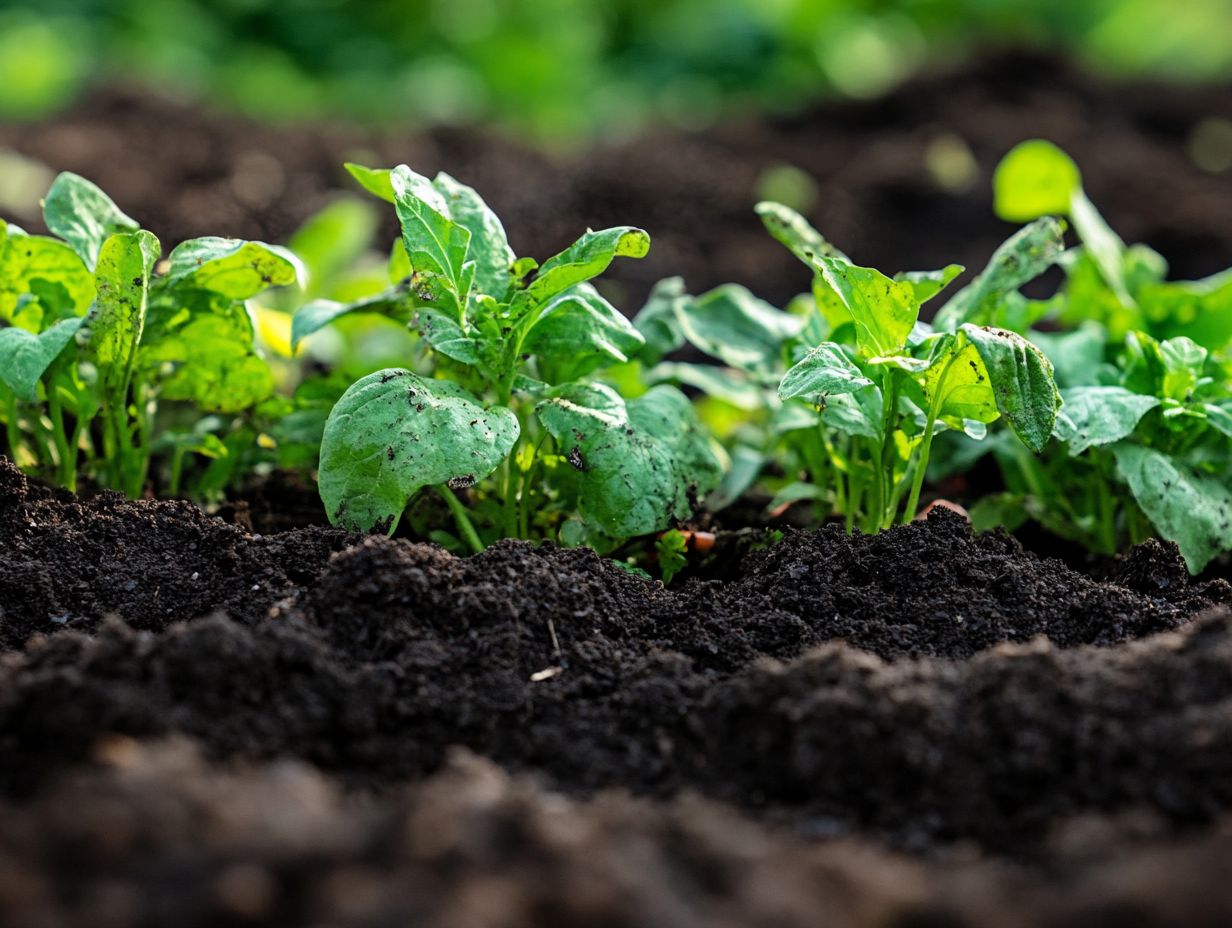Why Soil Aeration is Crucial for Water Retention
Soil aeration is essential for supporting healthy ecosystems, influencing everything from plant growth to the soil’s ability to retain water.
Grasping the significance of soil aeration reveals its role in helping plants get nutrients and reducing soil density. This exploration shows how aeration helps water retention and showcases the myriad benefits that come with it.
You ll discover effective techniques for achieving and sustaining optimal aeration in your soil.
Unlock the secrets to vibrant gardens today!
Contents
- Key Takeaways on Soil Aeration Benefits:
- Understanding Soil Aeration
- How Soil Aeration Affects Water Retention
- Benefits of Soil Aeration
- Methods of Soil Aeration
- Maintaining Proper Soil Aeration
- Frequently Asked Questions
- What is soil aeration and why is it important for water retention?
- How does soil aeration affect water retention?
- What are the benefits of soil aeration for water retention?
- When is the best time to aerate soil for water retention?
- Can soil aeration alone improve water retention?
- What are some effective soil aeration methods for improving water retention?
Key Takeaways on Soil Aeration Benefits:

- Ensure adequate soil aeration for proper water retention.
- Avoid poor soil aeration to reduce water runoff and nutrient loss.
- Use regular aeration methods, both mechanical and natural, to improve water retention and promote healthy plant growth.
Understanding Soil Aeration
Understanding soil aeration is essential for you as a farmer, as it directly impacts the health and productivity of your crops. Aeration allows oxygen to penetrate the soil, enabling roots to breathe and efficiently absorb vital nutrients and water.
It also plays a critical role in combating soil compaction, where soil becomes dense and hard, making it hard for roots to grow. This process ensures that beneficial microorganisms can thrive and maintain the ecosystem’s balance.
By implementing effective aeration practices, you can significantly enhance soil properties, creating optimal growth conditions for a variety of crops and promoting sustainable agricultural methods.
Try new aeration methods to improve soil structure and sustain a healthy environment for your crops.
Definition and Importance
Soil aeration refers to the process of introducing air into the soil, enhancing its oxygen content a crucial element for promoting plant health and growth in agricultural fields. This helps plants grow better and healthier.
This vital process allows roots to breathe, fostering beneficial microorganisms that play a key role in nutrient cycling. When soil becomes compacted and lacks sufficient air, plants find it challenging to absorb moisture and essential nutrients, which can stunt their growth.
By ensuring proper aeration, you improve water infiltration, reduce erosion, and enhance soil structure, making it more resilient against harsh environmental conditions. Well-aerated soil nurtures a balanced ecosystem and facilitates the healthy development of both plants and their surrounding environment.
How Soil Aeration Affects Water Retention
Soil aeration is essential for optimizing water retention. By improving the soil’s capacity to absorb and store moisture, it effectively minimizes the risks of waterlogging and saturation.
The Relationship Between Aeration and Water Retention
The connection between aeration and water retention is essential for nurturing healthy soil and fostering optimal crop growth.
When you implement effective aeration techniques, you significantly enhance the moisture-retaining capabilities of various soil types. This ensures that your plants have the water they need during those critical growth periods.
By allowing air to penetrate deep into the ground, you prevent soil compaction and create a network of channels that facilitate both water absorption and drainage.
This results in a well-balanced environment where nutrients can move freely and moisture is retained effectively, leading to stronger plants and improved agricultural yields. It s vital to understand the importance of maintaining soil structure and health, as these elements play a direct role in conserving water.
Benefits of Soil Aeration

The advantages of soil aeration reach well beyond simply boosting oxygen levels. You ll discover enhanced nutrient absorption, reduced soil compaction, and an overall improvement in the health of your crops.
Improved Nutrient Absorption
Aeration significantly enhances nutrient absorption, allowing your crops to access key nutrients like nitrogen, iron, and manganese with remarkable efficiency.
When you ensure proper soil aeration, oxygen levels in the root zone increase, nurturing a healthier, more vibrant microbial community a group of tiny living things in the soil that help plants grow. Improved aeration helps crops absorb nutrients more effectively.
Increased microbial activity breaks down organic matter. This process releases and mobilizes crucial nutrients. Nitrogen, essential for amino acid and protein synthesis, becomes more accessible, resulting in lush, green foliage. Concurrently, iron and manganese play pivotal roles in key processes like photosynthesis and chlorophyll production.
Act now! Alleviating compacted soil ensures your crops thrive and grow robustly, equipping them to flourish in various environmental conditions.
Reduced Soil Compaction
Reduced soil compaction stands out as one of the top advantages of regular aeration. It enables better root growth and enhances water infiltration.
When soil compaction strikes, it hampers the movement of air, water, and nutrients. This can stunt crop development and diminish yields, leading to stunted growth and greater vulnerability to pests and diseases.
By embracing consistent aeration practices, you improve soil structure and boost microbial activity. This fosters a more vibrant ecosystem that alleviates the burdens of compacted soil and ensures roots gain access to essential nutrients. Ultimately, this leads to healthier crops and cultivates more resilient agricultural systems.
Methods of Soil Aeration
Explore various exciting soil aeration methods to boost soil health, from mechanical techniques to organic practices.
Each approach works to create optimal growth conditions for your crops, ensuring they thrive.
Mechanical Aeration Techniques
Mechanical aeration techniques, such as core and spike aeration, are essential for alleviating soil compaction and enhancing overall soil structure.
These methods are vital for improving water infiltration and promoting robust root growth, ultimately leading to better crop yields. Core aeration involves removing plugs of soil, creating pathways for air and nutrients to reach plant roots while decreasing soil density.
Conversely, spike aeration employs solid tines to puncture the ground, allowing for rapid penetration without removing soil. Both techniques are particularly advantageous in agricultural landscapes where heavy machinery has compacted the earth.
By investing in effective tools for soil management, you can cultivate a more sustainable growing environment.
Natural Aeration Methods

Natural aeration methods, such as incorporating organic matter and utilizing cover crops, can significantly enhance soil aeration while simultaneously promoting overall soil health and fertility.
These practices improve airflow and water absorption while returning key nutrients to the soil. This fosters a vibrant ecosystem for beneficial microorganisms. Techniques like reduced tillage and crop rotation are crucial in maintaining soil structure and fertility, providing further advantages for sustainable agriculture.
By adopting these environmentally friendly approaches, you can cultivate crops without heavily relying on synthetic fertilizers. This nurtures a more harmonious relationship with the land. Embracing these organic methods makes the pursuit of resilient farming systems not just a possibility, but a promising reality.
Maintaining Proper Soil Aeration
Ensuring proper soil aeration is crucial for the long-term health and productivity of your crops. This requires you to implement best practices in soil management, laying the foundation for thriving agricultural success.
Best Practices for Long-Term Benefits
Implementing best practices in soil aeration yields long-term advantages. These include enhanced nutrient absorption and improved soil structure, which are vital for sustainable agriculture.
These practices are essential for nurturing a vibrant ecosystem in agricultural settings. They promote healthy root development while minimizing compaction. Incorporate methods like crop rotation, cover cropping, and strategic tillage. These practices significantly enhance aeration.
Using organic amendments like compost gradually increases soil porosity. Tools like aeration machines or simple techniques such as deep spiking are also remarkably effective.
Combining these strategies not only fosters robust plant growth but also sustains the cultivation of fertile soil. This ensures your crop productivity remains high for seasons to come.
Frequently Asked Questions
What is soil aeration and why is it important for water retention?
Soil aeration is the process of creating air spaces in the soil. This allows for better circulation and exchange of gases, preventing waterlogging and enhancing overall soil health.
How does soil aeration affect water retention?
Soil aeration is vital for boosting water retention! It creates air pockets that enhance moisture levels, crucial for thriving plants. This helps keep the soil moist, promoting healthy plant growth, especially in farming and agricultural practices.
What are the benefits of soil aeration for water retention?
In addition to improving water retention, soil aeration enhances nutrient absorption, reduces compaction, and promotes root growth. This results in healthier and more resilient plants, better equipped to withstand drought conditions and supporting the growth of various crops.
When is the best time to aerate soil for water retention?
The ideal time to aerate soil for water retention is during the growing season when the soil is moist but not saturated. This allows for better penetration of aeration tools and helps prevent damage to plant roots, ensuring that atmospheric oxygen and nutrients reach them effectively.
Can soil aeration alone improve water retention?
While soil aeration is crucial for improving water retention, it is not a standalone solution. Other factors, such as proper irrigation, mulching, and soil type, also play significant roles. Addressing these factors is essential for achieving optimal water retention.
What are some effective soil aeration methods for improving water retention?
Several methods can help improve water retention, including core aeration, spike aeration, and liquid aeration. These methods can be done manually or with the help of specialized tools like a lawn aerator. Consult a professional to determine the best method for your specific soil type and conditions.
Try these methods today to see an incredible difference in your soil health!







